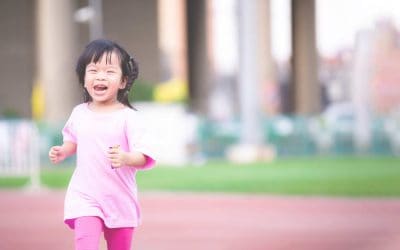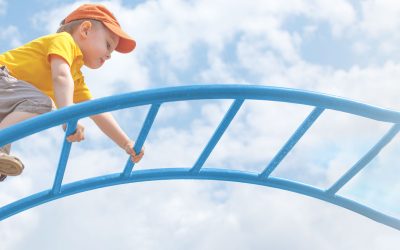Do babies need core stability exercises?
If my work came out with a yearbook, the favorite expression listed under my picture would probably be “fix your feet!” My “seen most often” would be running around the gym correcting the kids’ sitting positions and making sure they are not W-sitting.
But why am I doing this?
What’s so wrong with W-sitting?
I’ve had many people tell me that they have sat like that their whole lives and have never had any issues. While that may be true in some cases, there can often be problems or pain later in life that may be traced back to children sitting in the W. This can lead to the necessity for an occupational therapist later in life, but it doesn’t need to be that way.
Let me go into further detail.
What is W-sitting?
W-sitting is when a child sits on the floor with their bum between their legs, and their knees are bent in front of them, and their legs are rotated away from their body. From a birds-eye view, it looks like the legs are forming a “W.”

Why do kids use this sitting position?
Many children W-sit because this position is super stable for them to sit in. In W-sitting, a child’s base of support is wider, and the center of gravity is lower, which allows the child to stay upright with relative ease. This also makes the W position comfortable for the child to play in because they don’t have to keep their balance while focusing on their toys.
Why is it a concern?
From an orthopedic standpoint, W-sitting causes the hip and leg muscles to become shortened and tight. This can lead to “pigeon-toed” walking, knee problems and may increase the chance of back or pelvis pain as they grow due to increased internal hip rotation. In addition, when a child sits in the W, it is very stressful for the hip joint, leading to deformities later on and predisposing a child to hip dislocation or hip dysplasia.
Developmentally, a W-sitting habit can hinder the development of balance reactions and coordination. When W-sitting, children can’t shift their weight to their left and right sides or actively rotate their trunks, making it challenging to achieve cross-body movements, such as reaching toys outside their immediate reach. Lateral weight shifting and rotating are two critical skills needed to develop good balance reactions and develop the ability to cross the midline. Bilateral coordination (the ability to effectively use both sides of the body together) is delayed as a result. This can influence the development of other fine motor skills that require this coordination, such as hand dominance (or hand preference), skipping, throwing, and kicking.
What can you do to help? Core stability exercises and other sitting positions
If a child is frequently in a W position, it is usually a sign of core muscle weakness. When the core is weak, the child needs to have a stable position to play, so W-sitting is their solution to that problem. However, a weak core can lead to poor posture, low muscle tone, overcompensation of other muscle groups, and further delayed fine motor development. So if your child is a W-sitter, here are a few things you can do to help correct it:
● Encourage other positions. Sitting with legs crossed (‘criss-cross applesauce’!), side sitting (legs on the same side), long sitting (legs straight out in front), or sitting on a low bench or stool (legs bent).
● When playing for an extended period, place stickers on their toes and remind them that they always have to see the stickers as they sit.
● Core stability exercises:
-
- Bridging: Have your child lie on their back with their knees bent and feet flat on the floor. Please encourage them to lift their bum off the floor. Be sure that they are keeping their head and shoulders on the ground. I like to see how many toy cars they can let go under their bridge to encourage them to hold it.
- Crab walking: Have your child sit on the floor with their knees bent in front of them and their hands supporting them behind them. Encourage them to lift their bum and try and take a few “steps” with their hands and feet.
- Wheelbarrow walking: Have your child lay on their stomach on the floor. While you hold the child’s knees (easier) or ankles (a bit more of a challenge), have them walk their hands forward ten steps and backward ten steps as they attempt to get their legs straight.
- Play row-row your boat (great adult core strengthening too!)
- If you find that your child has a hard time maintaining any comfortable position besides W-sitting, speak with your pediatrician or a physiotherapist for suggestions on correcting the position and treating any underlying strength deficits or muscle tightening that may have resulted from your child’s w sitting.
Check this out for another great article on this topic.
Quick Tips:
- Try and discourage W-sitting
- Reminder – “fix your feet!”
- Work on improving core strength
- Help encourage other ways to sit
Does your child have a flat head? Are you confused about baby carriers? Is your baby not crawling?
FAQs
What Do You Do for W-Sitting?
There are many ways to combat the detrimental effects of W-sitting. Core stability exercises are critical, as W-sitting is often the result of having poor core strength. If you can help your child strengthen their core, they might not feel the need to sit in this position.
Bridging, crab walking, and wheelbarrow walking are all great exercises that help build core muscles.
YouTube is an excellent resource for finding instructional videos on light muscle work. Even something as simple as having a child walk on their knees (on the carpet, of course) for a short period will strengthen both their core and their glutes.
Additionally, parents should continuously encourage better sitting habits. If you see your child sitting in the w position, encourage an alternative sitting position where the child’s legs are crossed or their feet tucked underneath them. Other positions such as a side sit, extended sit, or half-kneel may also keep your child from being formally diagnosed with debilitating knee problems.
When you’re doing any of these, it’s essential that you talk to your child about their posture and show them how they should change positions. Remember, the child has no idea that they’re doing anything wrong, so they feel no need to correct it. This is especially true for younger children.
At What Age Is W-Sitting Bad?
No matter what age you are, W-sitting is never a great idea. That being said, it’s a horrible idea for younger children because they’re still developing. It can lead to them becoming in-toed (or pigeon-toed) later in life. It can also influence bone and hip development, preventing them from aligning correctly and causing serious issues later in life, requiring occupational therapy.
As an adult, your bones have finished growing. At the same time, it can still lead to hip or knee pain due to the unnatural load you’re putting on the ligaments and joint structures. Finding other sitting positions that allow you to sit upright can be crucial to combat muscle tightness. Try to remember that it is always better to have your feet touching while you sit.
For children and full-grown adults alike, W-sitting is never a great idea.
Why Is It Bad If My Child Sits In the W?
When someone is in a W-sitting position, their knees are rotated inward. This puts a lot of stress on the knees and hips and can lead to knee pain or hip dysplasia. Fortunately, it only presents a problem if the children sit in this position for extended periods. There likely won’t be any adverse side effects if the child moves around a lot and is in and out of a W-sitting position.
It can also hinder crucial child development like gross motor skills (whole-body movements). Children like W-sitting because it provides a lot of stability, but that stability can be immobilizing. It’s natural for kids to wander and fidget, and it plays a vital role in developing balance reactions and coordination.
How Do You Explain W Sitting?
The phrase “W-sitting” is slightly misleading because the position doesn’t resemble traditional sitting but is almost more similar to kneeling. When someone W-sits, they fold their legs out to the sides and their knees in, so if you were to look at them from above, their legs would form a “W” shape. It almost seemed like someone was kneeling, and their legs gave out, shooting out to the sides of the body. Considering how dangerous the position can be, that might be an appropriate description!










